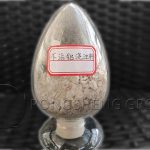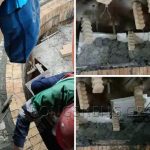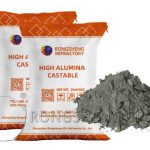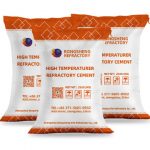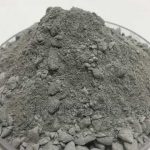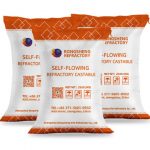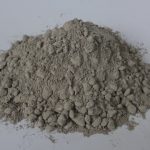10%, 15%, and 20% (w) andalusite was introduced into low-cement high-aluminum castables to study the effect of andalusite addition on the high-temperature performance of the castables. The results show that the addition of andalusite can improve the volume stability of low-cement high-aluminum castables. With the increase of andalusite addition, its load softening temperature and high-temperature flexural strength show a gradual upward trend. The high-temperature performance of low-cement high-aluminum castables can be improved by using andalusite mullitization at high temperature.
Effect of Adding Andalusite on the High Temperature Performance of Low-Cement High-Aluminum Castable
- (1) Adding andalusite to low cement high aluminum castable can significantly improve the volume stability of low cement high aluminum castable.
- (2) Adding 20% (w) andalusite increases the load softening starting temperature by about 125℃ and the high temperature flexural strength by about 69% compared with the sample without andalusite. The introduction of andalusite can significantly improve the high temperature flexural strength and load softening temperature of low-cement high-aluminum castable.

Precautions for the construction of high-aluminum low-cement castables for rotary kiln lining
The construction of high-aluminum low-cement castables for rotary kiln lining requires special attention to the following five processes.
-
Determination of expansion joints.
Based on the previous experience of using high-aluminum low-cement castables, expansion joints are a key factor affecting the service life of rotary kiln castable linings. The expansion joints during the pouring of rotary kiln linings are determined as follows:
- (1) Circumferential joints: 5m sections, with 20mm aluminum silicate fiber felt sandwiched between the castables. After expansion, the fibers are compacted to buffer the expansion stress.
- (2) Flat joints: Every three strips of the castable are sandwiched with 100mm deep plywood in the inner circumferential direction, with a gap left at the working end, for a total of 6 strips.
- (3) During pouring, 25 exhaust pins are used per square meter to release a certain amount of expansion stress while exhausting the kiln.
-
Determination of construction temperature
The most suitable construction temperature for high-aluminum low-cement castables is 10~30℃. If the ambient temperature is low, the following measures should be taken:
- (1) Seal the surrounding construction environment, add heating facilities, and prevent freezing.
- (2) Use 35-50℃ hot water to mix the materials, depending on the on-site pouring test vibration conditions.
-
Mixing
Determine the mixing amount at one time according to the capacity of the mixer. After the mixing amount is determined, add the casting material in the bag and the small package additives in the bag into the mixer at the same time. Start the mixer for dry mixing for 2~3 minutes, then add 4/5 of the weighed water and stir for 2~3 minutes. Then determine the addition of the remaining 1/5 of water according to the viscosity of the mud, and conduct trial casting after sufficient mixing. Combined with the vibration and slurry situation, determine the best amount of water to add. After the amount of water is determined, it must be strictly controlled. While ensuring that the vibration and slurry can be stirred, try to add as little water as possible (the reference water addition amount for this castable is 5.5%-6.2%).
-
Construction
The construction time of high-aluminum low-cement castable is about 30 minutes. Dehydrated or condensed materials cannot be mixed with water and used, and should be discarded resolutely. Use a vibrating rod to vibrate to achieve slurry compaction. The vibrating rod should be spared so that the spare rod can be activated when the vibrating rod fails.
The construction of the castable should be carried out in strips along the axis of the rotary kiln. Before each casting, the construction surface should be cleaned and dust, welding slag and other debris should not be present. At the same time, check whether the welding of the anchors and the surface asphalt paint treatment are in place. Otherwise, remedial measures should be taken.
In the strip construction, the construction of the first casting body should be openly cast from the kiln tail to the kiln head at the lower part of the kiln body. The template should be supported between the anchor and the steel plate. The steel plate and the anchor are firmly inlaid with wooden blocks. The support formwork height is 220mm, the width is 620mm, the length is 4-5m, and the center angle is 22.5°.
The construction of the second casting body should be carried out after the first one is finally set and demolded. On one side, the method of supporting an arc template is used to cast from the kiln head to the kiln tail. The rest is analogous.
When the castable is vibrated, the mixed mud should be added to the tire mold while vibrating. The vibration time should be controlled so that there are no obvious bubbles on the surface of the cast body. The demoulding time should be determined according to the ambient temperature of the construction site, and demoulding should be ensured after the castable has finally solidified and has a certain strength.
-
Baking of the lining.
The quality of the baking of the rotary kiln lining directly affects the service life of the lining. In the previous baking process, due to the lack of mature experience and good methods, the method of spraying heavy oil for combustion was used in the low-temperature, medium-temperature and high-temperature baking processes, and the temperature was difficult to control. When the temperature needs to be controlled below 150℃, the heavy oil is not easy to burn. When the temperature is higher than 150℃, the heating speed is too fast, and the temperature distribution in the kiln is very uneven. The temperature of the lining at the heavy oil combustion point is about 350~500℃ higher, while the temperature of other parts is low. In this way, the lining is easy to burst (the previous castable lining has burst during the baking process), which affects the service life of the lining.

